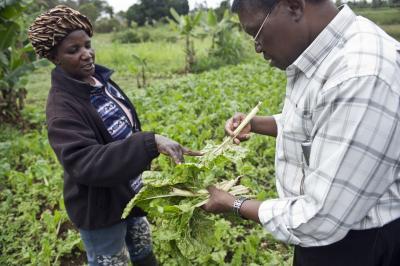While the developed world has levels of scientific and technical capacity that allow crop pests to be effectively managed, poorer nations, where food production is incredibly important, are caught in a tug-of-war between modern agriculture and an activist culture that tells them not to trust science.
As a result, not only are crop pests not effectively managed, with the disastrous drops in yields that brings, but no one can even be sure what crop pests there are.
The abundance of crop pests in developing countries may be greatly underestimated, according to an analysis of data on the known distributions of almost 2,000 crop-destroying organisms in 195 countries. Dr. Dan Bebber and Professor Sarah Gurr, of Biosciences at the University of Exeter, say many developing countries harbor hundreds of unreported crop pests and diseases, based on current levels of agricultural productivity.
Up to 20 percent of the world's agricultural production is lost to destructive organisms annually, with further losses post-harvest. Obviously the bulk of those losses occur where modern technology isn't in use, like organic farming and developing nations. The problem isn't just native species. Developing countries are also less likely to have the capacity to observe invasive species than affluent, technologically-advanced nations and crop pests can be introduced by human activities such as trade and travel.
Using GDP and scientific output as indicators of pest detection capacity, the study found that the pest load of the developing world appears to be greatly underestimated, and that this lack of knowledge may be severely hampering crop protection in some of the world's most important food producing nations.

Kale growers in Kenya assess their crop for pests. Photo Credit: CABI
Bebber says, "Country wealth is likely to be a strong indicator of observational capacity, not just trade flow, as has been interpreted in previous studies of invasive species. If every country had US-levels of per capita GDP, then on average countries woul
d be reporting more than 200 additional pests and diseases. This suggests that enhanced investment in pest observations will reveal the hidden threat of crop pests and pathogens, as well as bring into focus the opportunity to lose less of the crop by appropriate pest control. The first step to solving crop losses is to identify the pests responsible."
The largest numbers of crop pests were reported by the USA, followed by India, China, France and Japan. Island nations reported more pests than coastal and landlocked nations, and the number of pests increased slightly with rainfall.
Professor Sarah Gurr added: "This follows hot on the heels of our recent paper showing that pests and pathogens are on the move in the face of climate change. When coupled to this study we can see that many nations are underestimating pest and pathogen loads. Taken collectively, these papers draw attention not only to the threat of crop disease, and thus global food security, but also to our need for more trained pathologists to inform policy."




Comments